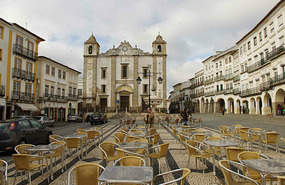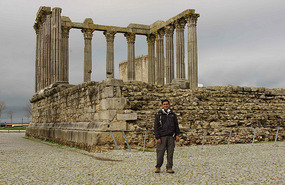We had a positively relaxing day of touring today, leaving our campsite in Costa di Caprica almost at 11 am. Megs drove over a hundred kilometers east towards Évora. This small city is located in the plains of Southern Portugal, closer to the Spanish border than to the Atlantic Ocean. About a twenty minute drive outside town, along a dirt (more a muddy clay after all this rain) road, we saw the cromlechs (Portuguese rocks in a formation similar to Stonehenge). We haven't seen Stonehenge itself, but I’m pretty sure they’re a lot larger and awe-inspiring. Nonetheless, it was still very neat to wander around something that was over 4000 years old. It was so quiet out there, and with almost no one else around, you could almost imagine what it would have been like all those years ago.
The rocks themselves, most around six to seven feet tall and a few feet wide, were arranged in an oval shape. The hundred or so granite rocks are believed to have been a celestial calendar dating from around 2000 BC. The drive to and from the site was also fascinating to us because we got to go through a cork tree plantation. We got to see harvested cork trees and were close enough to touch them – and yes, the bark feels just like cork! It was interesting to note the deep maroon color of the tree trunk underneath the harvested portion of the tree. We had seen quite a few cork tree plantations on our drive inland this morning and it was nice to finally get up close to the trees that accounted for about 60% of the world’s cork production. The remainder of the world’s supply comes from Spain.
We arrived at our campsite just in time for a quick lunch break and then made our way to the town of Évora, just a few kilometers away. We parked outside the medieval walls of the old town– designated a UNESCO site since 1986 – and began a self-guided walking tour of the town. Évora has a rich history, dating from Roman times and also included the Moors and Portuguese kings. Most of the roads lining the old town are narrow and made of tiny cobble stones. This along with the tightly packed two to three storey houses gives it a certain quaint feel.
The main square, Praça do Giraldo, was quite a lively square with people milling about, lots of vehicle traffic (that definitely detracted from the medieval town feel) and two roasted chestnut vendors sending plumes of smoke into the air on one corner of the square. Many of the buildings have a yellow trim which is believed to repel evil spirits although we’re not sure if that’s why they’re painted so nowadays or just to preserve the heritage.
We wandered through the town spotting remnants from the Roman days such as old walls, parts of an aqueduct, an old Roman bath that is being excavated in the foundation of the town hall and Roman arches. Most of the excavations of these Roman ruins occurs accidentally today when some new construction or plumbing work has to be performed. The highlight of the tour was seeing the Roman temple with its fourteen Corinthian columns still standing erect, in the center of a square, surrounded by a public garden, a church and a building that was the site of a bloody inquisition.
From the square, we wandered down the street and saw (only from the outside as it is not open to the public) where Vasco de Gama used to live after he discovered the trade route to India. I thought it was pretty neat to see this as this man was largely responsible for Portugal’s rise to power in the 1500’s. We had seen his tomb in Lisboa and now we had seen the house where he once lived.
Having completed our walking tour, we made our way back to the campsite and stopped by at a grocery store to stock up on food for the next few days. We got into camp around six in the evening and were pleasantly surprised to find that it was still light out. We’d had a very pleasant day of relaxed touring and were ready to head to the most south-western point in Europe tomorrow.
Cromlechs, Cork Groves & Roman Ruins
Thursday, January 24, 2013
 Évora, Alentejo, Portugal
Évora, Alentejo, Portugal
Other Entries
-
70Royan
Nov 1966 days prior Royan, Francephoto_camera9videocam 0comment 4
Royan, Francephoto_camera9videocam 0comment 4 -
71A second visit to London
Nov 2560 days prior London, United Kingdomphoto_camera93videocam 0comment 15
London, United Kingdomphoto_camera93videocam 0comment 15 -
72En route to Bangalore
Nov 2659 days prior Dubai, United Arab Emiratesphoto_camera10videocam 0comment 3
Dubai, United Arab Emiratesphoto_camera10videocam 0comment 3 -
73Bangalore
Dec 1639 days prior Bangalore, Indiaphoto_camera134videocam 0comment 17
Bangalore, Indiaphoto_camera134videocam 0comment 17 -
74London, our third and final visit?
Dec 1936 days prior London, United Kingdomphoto_camera32videocam 1comment 2
London, United Kingdomphoto_camera32videocam 1comment 2 -
75Visiting friends in Scotland
Jan 0420 days prior Beith, United Kingdomphoto_camera68videocam 0comment 4
Beith, United Kingdomphoto_camera68videocam 0comment 4 -
76Preparing for new adventures
Jan 0816 days prior Royan, Francephoto_camera3videocam 0comment 0
Royan, Francephoto_camera3videocam 0comment 0 -
77Citadel in Blaye & Dune de Pilat
Jan 1014 days prior Blaye, Francephoto_camera13videocam 0comment 0
Blaye, Francephoto_camera13videocam 0comment 0 -
78Minh-Yen arrives!
Jan 1113 days prior Zarautz, Spain and Canary Islandsphoto_camera7videocam 0comment 0
Zarautz, Spain and Canary Islandsphoto_camera7videocam 0comment 0 -
79Tapas in San Sebastian
Jan 1212 days prior San Sebastián - Donostia, Spain and Canary Islandsphoto_camera37videocam 0comment 6
San Sebastián - Donostia, Spain and Canary Islandsphoto_camera37videocam 0comment 6 -
80Biarritz
Jan 1410 days prior Biarritz, Francephoto_camera27videocam 0comment 2
Biarritz, Francephoto_camera27videocam 0comment 2 -
81St. Jean de Luz
Jan 159 days prior Saint-Jean-de-Luz, Francephoto_camera19videocam 0comment 4
Saint-Jean-de-Luz, Francephoto_camera19videocam 0comment 4 -
82An unforgettable lunch in Bilbao
Jan 168 days prior Bilbao, Spain and Canary Islandsphoto_camera28videocam 0comment 1
Bilbao, Spain and Canary Islandsphoto_camera28videocam 0comment 1 -
83Sipping Port in Porto
Jan 195 days prior Porto, Portugalphoto_camera64videocam 0comment 2
Porto, Portugalphoto_camera64videocam 0comment 2 -
84Batalha Monastery
Jan 204 days prior Batalha, Portugalphoto_camera18videocam 0comment 0
Batalha, Portugalphoto_camera18videocam 0comment 0 -
85Nazaré, Alcobaça & Óbidos
Jan 213 days prior Alcobaca, Portugalphoto_camera57videocam 1comment 0
Alcobaca, Portugalphoto_camera57videocam 1comment 0 -
86Lisbon
Jan 231 day prior Lisbon, Portugalphoto_camera99videocam 0comment 0
Lisbon, Portugalphoto_camera99videocam 0comment 0 -
87Cromlechs, Cork Groves & Roman Ruins
Jan 24 Évora, Portugalphoto_camera25videocam 0comment 2
Évora, Portugalphoto_camera25videocam 0comment 2 -
88Boat trip around the Lagos rocks
Jan 262 days later Lagos, Portugalphoto_camera46videocam 1comment 0
Lagos, Portugalphoto_camera46videocam 1comment 0 -
89News Flash:Tourist spotted swimming in the Algarve
Jan 262 days later Lagos, Portugalphoto_camera3videocam 0comment 0
Lagos, Portugalphoto_camera3videocam 0comment 0 -
90Seville
Jan 284 days later Seville, Spain and Canary Islandsphoto_camera70videocam 0comment 0
Seville, Spain and Canary Islandsphoto_camera70videocam 0comment 0 -
91White Hill town of Ronda
Jan 306 days later Ronda, Spain and Canary Islandsphoto_camera39videocam 0comment 1
Ronda, Spain and Canary Islandsphoto_camera39videocam 0comment 1 -
92A Taste of Tangier
Feb 029 days later Tangier, Moroccophoto_camera49videocam 0comment 3
Tangier, Moroccophoto_camera49videocam 0comment 3 -
93The Rock of Gibraltar
Feb 0310 days later Gibraltar, United Kingdomphoto_camera33videocam 0comment 1
Gibraltar, United Kingdomphoto_camera33videocam 0comment 1 -
94Paella feast in Nerja
Feb 0411 days later Nerja, Spain and Canary Islandsphoto_camera20videocam 0comment 1
Nerja, Spain and Canary Islandsphoto_camera20videocam 0comment 1 -
95The Alhambra in Granada
Feb 0512 days later Granada, Spain and Canary Islandsphoto_camera85videocam 0comment 1
Granada, Spain and Canary Islandsphoto_camera85videocam 0comment 1 -
96Snacking our way through Madrid
Feb 1118 days later Madrid, Spain and Canary Islandsphoto_camera41videocam 0comment 1
Madrid, Spain and Canary Islandsphoto_camera41videocam 0comment 1 -
97El Escorial: A cold grey palace
Feb 1219 days later El Escorial, Spain and Canary Islandsphoto_camera6videocam 0comment 0
El Escorial, Spain and Canary Islandsphoto_camera6videocam 0comment 0 -
98Fascist Church, Aqueduct and Segovian Tasting Tour
Feb 1320 days later Segovia, Spain and Canary Islandsphoto_camera27videocam 0comment 1
Segovia, Spain and Canary Islandsphoto_camera27videocam 0comment 1 -
99Holy Toledo!
Feb 1421 days later Toledo, Spain and Canary Islandsphoto_camera63videocam 0comment 1
Toledo, Spain and Canary Islandsphoto_camera63videocam 0comment 1 -
100Modernisme sights in Barcelona
Feb 1825 days later Barcelona, Spain and Canary Islandsphoto_camera225videocam 1comment 1
Barcelona, Spain and Canary Islandsphoto_camera225videocam 1comment 1 -
101Day trip to Sitges
Feb 1926 days later Sitges, Spain and Canary Islandsphoto_camera11videocam 0comment 0
Sitges, Spain and Canary Islandsphoto_camera11videocam 0comment 0 -
102Cassoulet in Carcassonne
Feb 2633 days later Carcassonne, Francephoto_camera19videocam 0comment 2
Carcassonne, Francephoto_camera19videocam 0comment 2 -
103Albi: Toulouse-Lautrec & amazing cathedral
Feb 2734 days later Albi, Francephoto_camera15videocam 0comment 0
Albi, Francephoto_camera15videocam 0comment 0 -
104Bastides in the Lot
Feb 2835 days later Cordes-sur-Ciel, Francephoto_camera24videocam 0comment 3
Cordes-sur-Ciel, Francephoto_camera24videocam 0comment 3 -
105Return to Rocamadour
Mar 0136 days later Rocamadour, Francephoto_camera9videocam 0comment 0
Rocamadour, Francephoto_camera9videocam 0comment 0

 Évora, Alentejo, Portugal
Évora, Alentejo, Portugal































2025-05-22